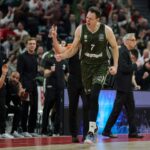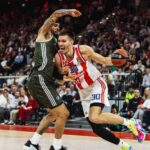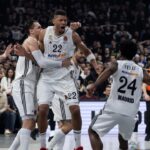 Yesterday, BallinEurope.com ran part one of Francesco Cappelletti’s analysis and forecast of Italy’s first six Serie A teams for 2009-10. Below runs part two, covering the remaining 10 hopefuls from the top Italian league.
Yesterday, BallinEurope.com ran part one of Francesco Cappelletti’s analysis and forecast of Italy’s first six Serie A teams for 2009-10. Below runs part two, covering the remaining 10 hopefuls from the top Italian league.
Angelico Biella. Last year’s semifinal is only a memory: Biella must again plunge into the tough reality of its life as small basketball center among wealthier clubs and cities. On the other hand, the peacefulness and consciousness working in Biella makes it easier than in Milano to remain in Northern Italy. That’s what Fred Jones was surely thinking when he decided to cross the ocean and leave the NBA. The dunk specialist from Malvern is the noisiest acquisition an Italian club made this summer, and Jones could easily be Serie A MVP if he stays healthy. Joe Troy Smith is delegated to assist him, above and beyond scoring his usual 15 points per game, with support essential to a squad which has only one other pure shooter in Pietro Aradori. Aradori is set to confirm his past progress before returning to Roma, owner of his contract.
Coach Luca Bechi still seeks a backup point guard, after Valerio Spinelli did not agree with the club and stayed in Piemonte, mainly for economic reasons. To replace Vanja Plisnic, identified as starting power forward and now injured (out for two to three months), Sven Schulze has arrived. Centers Kieron Achara and Pervis Pasco don’t possess evident scoring tools, but their athleticism and dynamism keep the rhythm and tempo elevated. Matteo Soragna is the returning flagship who has been asked to be a locker room leader.
Pepsi Caserta. With a new and prepared coach – Stefano Sacripanti, who was great in Cantù and sufficient in Pesaro – and a sensational catch in Jumaine Jones, Caserta resets from an unlucky last season to begin another full of promise and renewed ambition. Jones has to expiate the sins of last year, when he signed with Armani Jeans Milano and Ural Great Perm at the same time, and must show the desire to play again at those standards of two years ago in Napoli, where half a season was enough to make him an idol and maybe the most talented player in Serie A. Jones’ pre-season has been encouraging, as have Caserta’s strong and convincing performances against Serie A rivals. Newcomer Timmy Bowers is fundamental for Sacripanti, due to his ability to play three spots and his court vision: He’ll help captain Fabio Di Bella and Lukasz Koszarek in handling the entire playbook, which has been announced as heavy. Ebi Ere is a guard without European experience and is very physical and unselfish. Antanas Kavaliauskas, Andrea Michelori and Phil Martin are great fighters near the basket. Caserta has a lot of points in its hands, though must raise its defensive intensity if the target is a playoff appearance.
Scavolini Spar Pesaro. Top scorer Mickael Hicks is no longer alone, but has Marques Green resolved those foot problems which interrupted his rise to the Euroleague level? That’s the main question Pesaro fans are afraid of, because Green can be considered a champion here in Italy, if he recovers the condition he had in Avellino two years ago. When he shined along with Eric Williams, the old-school center bought by Pesaro to again create a duo which must be the cornerstone of coach Dalmonte’s starting five. Instead, Williams has unspecified stomach problems that he wants to take care of in the US, so he’s out for a month or two; in his place is Lance Allred, a fugitive from Napoli. Without a pivot good at anchoring the paint and taking a position near to the basket, Marques Green has to be a finisher and not only a driver, to get the best out of Sam Van Rossom and Dusan Sakota. A team with too short a bench (Simone Flamini, Casey Shaw, full stop) and not-so-strong possibilities to score more than 70 points, whether or not Hicks and Green combine for 35 points per game.
Sigma Coatings Montegranaro. Few people look at Montegranaro as one of the likely candidates for a playoff spot. Maybe last summer’s episodes – Shawn Kemp’s trick and GM Roberto Carmenati’s departure – are still fresh in the minds of fans and journalists. Despite this, to me Montegranaro made smart moves on the smart market, with some acquisitions underestimated early but worth mentioning in a hypothetical list of “deals”. Robert Hite comes from Belgium (Oostende), but his previous experiences at a high European level – a few games with Tau Vitoria, then at Galatasaray Istanbul – suggest he can become a top player in Italy. He’s the perfect combo-guard lookalike, can handle the ball and score from the distance, can assists and get to the rim. To make him free to create for himself and his teammates, Anthony Maestranzi is the solution on the backcourt while Marquinhos is the other star in waiting for new coach Fabrizio Frates. The Brazilian, coming from NBA and just in Montegranaro in 2005, is a small forward of 207 centimeters, capable in the mid-range game and overpowering when shooting from distance against shorter defenders or forwards not so happy to leave the the paint. Under the basket, logically there’re two fighters in Greg Brunner (last year in Biella) and Bulgarian Dejan Ivanov, who at the end of last season caught eight rebounds in 25 minutes per game, with Brandon Hunter before him. Pay attention to Michele Antonutti, a possible starter at small forward, while Luca Lechtaler and Daniele Cavaliero are in search of verification of their Serie A careers.
Air Avellino. Dee Brown is as talented as Morris Finley; DeMarcus Nelson is as skilled as Ricky Minard; Cenk Akyol is as worthy as Davor Kus. So why are they in Avellino trying to avoid relegation to Legadue while their counterparts are with more important clubs? Perhaps the simple past form should be used: Brown, Nelson and Minard *were* as talented as, etc. Avellino has bet on men who could soon be waived or just as easily become heroes like Marques Green, Devin Smith and Eric Williams were. We have to see how Cesare Pancotto explains to a backcourt composed of guards used to dribbling for 15 seconds per play that there’s only one ball to play with, and that it must be passed to a low-post scorer like Chevon Troutman. Szymon Szewczyk has improved his scoring tools and he’s ready to stay on the court for at least 20 minutes, Filip Dylewicz is the only pure wing in the roster, and he can play power forward sometimes as well. Anyway, everything depends on the Brown-Nelson-Akyol trio, with the Turkish guard who must take advantage of Avellino’s opportunit, to get a national-team call-up in the year of Turkish World Championships and restore his reputation at the highest levels.
Carife Ferrara. A nice city to visit, to eat and to see a good basketball team. In its second year in Serie A, Ferrara established itself as a solid presence in the Italian panorama. This year, management wanted to build a team not only strong enough to battle to remain in the first league, but also fun to watch. So Anthony Grundy and Luke Jackson are in, and goodbye was wished to flag-bearer Andre Collins. Grundy is coming off two devastating seasons at Panellinios, where he often did more than they asked him; he’s overdue to take control of Ferrara’s operations, representing a dependable go-to guy on a team that, apart from Luke Jackson (not as crack as some think: He’s a tremendous shooter but has to be served in the right way to be fruitful), has not a lot of talent. Yohann Sangarè believes he is a worthy Euroleague playmaker and he’ll get the chance to prove it in Ferrara, where he’s the starting point guard; Harold Jamison and Joel Salvi (over to Oluoma Nnamaka) are not at all convincing for a roster that a Grundy demands. That’s the conundrum: Grundy runs, Ferrara walks.
NGC Medical Cantù. Cantù’s budget goes down year after year, but in the end, GM Bruno Arrigoni succeeds on scooping up players – often unknowns – from all around the world to stay in Serie A. Baby coach Andrea Trinchieri (who just guided Cremona to the first league) hopes the magic happens again, so as not to fail in his first experience among more high-level coaches. Othyus Jeffers, an athletic player who loves to attack the basket but is only 195 cm tall is the new name coming from US minor leagues, and his pre-season has pleasantly surprised all those managers too tired to go to America to see players like him. Jeffers is a risk, and the insurance policy is Maarten Leunen, the former Darussafaka Istanbul forward (averaging 12.8 points and 6.2 rebounds) who does his best when he can shoot from five meters out, and shooting guard Manuchar Markoishvili, just 23 but with a long career in Europe (with Benetton Treviso, Mitteldeutscher, Union Olimpija, and BK Kiev). From Rieti arrived Jerry Green, a setup man whose brain is brighter than his talent: That counts in Cantù, where the others are role players (Nicolas Mazzarino, Benjamin Ortner, Tautvydas Lydeka) and Arrigoni is sure he doesn’t have to repair their mistakes.
Vanoli Cremona. This newcomer from Legadue hasn’t a great tradition, but is the expression of an Italian area full of businessmen and opulence. So in its first year in Serie A, Cremona has built a team which can ask for something more than simple safety. E.J. Rowland is a guard who deserves attention after remarkable seasons in Germany and a Eurobasket 2009 played with Bulgaria thanks to his passport. He’s a modern point guard, doesn’t tend to overplay and has a nice feel for the game. He’s consistent, and “consistency” is the thing coach Stefano Cioppi wants from his men — and mainly from Gary Forbes, in Italy again after Napoli’s swindle last summer. Huge expectations are on Forbes, a powerful forward who knows how to use his body either against guards or big men, and is useful in several zones of the court. Consistency is what Vangelis Sklavos (last year in Rieti), Brandon Brown (last year in Teramo) and Troy Bell will surely give to Cremona, while the Italian core is led by Marco Cusin and his desire to emerge: He’s the starting center, with Sklavos behind him, and he can’t go wrong. Look at the names: Would you be able to tell Cremona is enjoying its Serie A debut?
Cimberio Varese. One year of Legadue hell for a club which has so many Italian championships and Euroleague trophies inside its showcase was sufficient. Now it’s time for Varese to try to remain in Serie A, even if the team hasn’t much money to steal an interesting player or two from mid-level teams. Ronald Slay and Jobey Thomas arrive after being turned down by a number of Italian teams; Michel Morandais is not at fault if his career’s gone south since his physique hasn’t held up; Randolph Childress, nearly 38 years old (!), needs an oxygen tank under the bench. As it stands, captain Giacomo Galanda remains the key to a team endowed with valuable young Italians: forward Nicolò Martinoni, on loan from Treviso for a second year, center Riccardo Antonelli, and guard Fabio Mian (born in 1992). If nothing works with the “seniors,” coach Pillastrini can teach his “juniors” instead.
Martos Napoli. This team was once called Nuova Sebastiani Rieti, and it failed at the end of last season. Its owner is Gaetano Papalia, who has found a way to continue his dubious activity in Italian basketball by moving the club from Rieti to Napoli, whose own team itself failed a year ago. This attempt at deceit has just been unmasked, however, with the revelation that Papalia has no money to pay players (Lance Allred and J.R. Reynolds have just fled), coaches, or infrastructure. Today, Napoli-Rieti has eight players and some youth. It’s the result of the reigning chaos here in Italy, where a new rule declares that, starting with the 2010-2011 season, the penultimate team will pay €500,000 euros to the second newcomer from Legadue in order to remain in Serie A. That’s what a man like Gaetano Papalia wants and that’s why Italian professional basketball is hopeless.




Leave a Reply